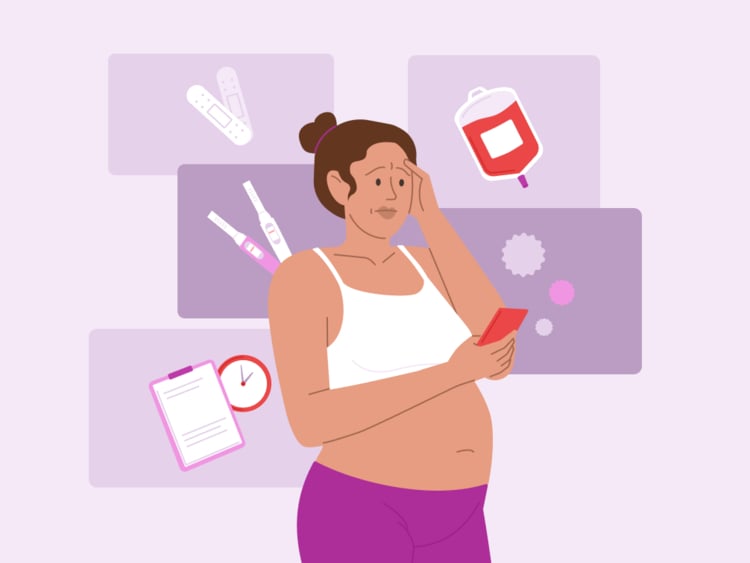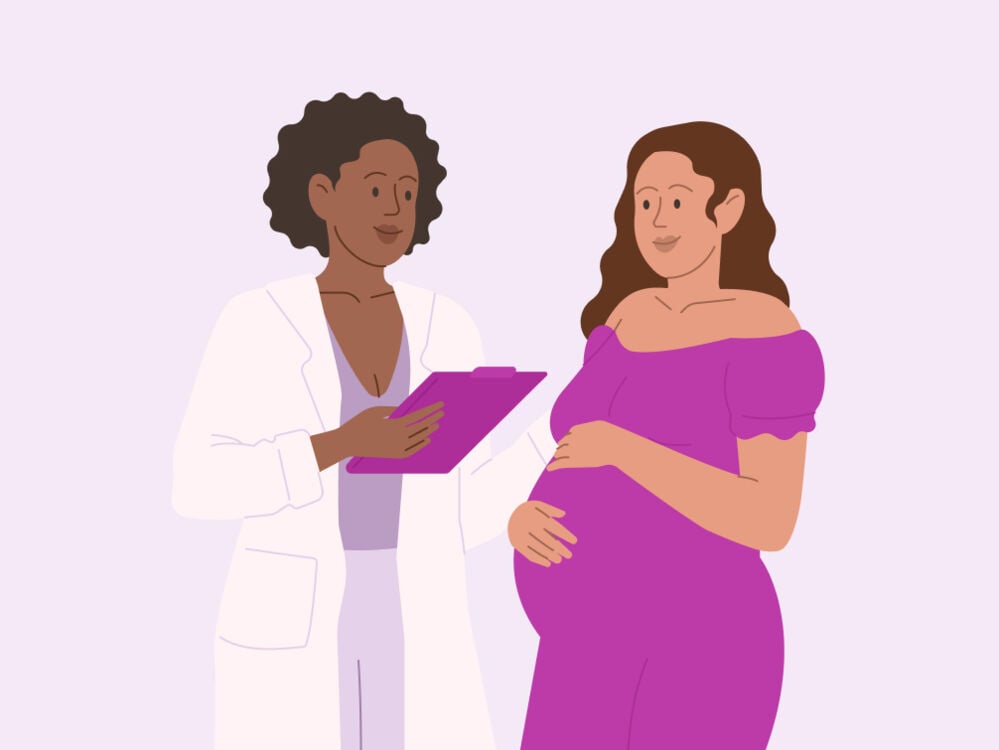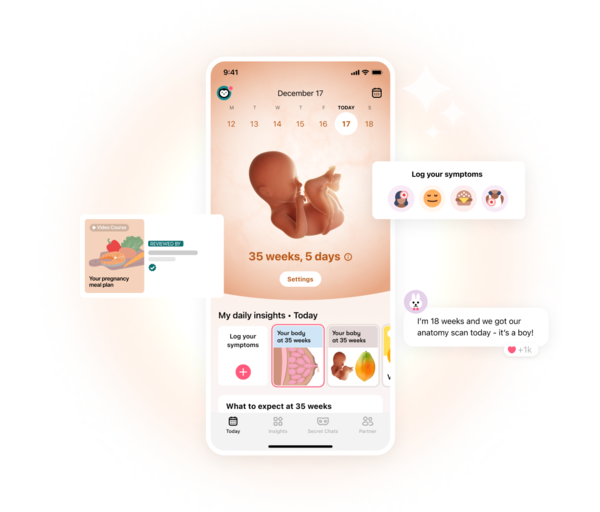When your doctor recommends a cesarean section (C-section), it’s a big moment for any mom-to-be. Why is your doctor saying it? Do you really need to have one? And is it really the best thing for you and your baby?
-
Tracking cycle
-
Getting pregnant
-
Pregnancy
-
Help Center
-
Flo for Partners
-
Anonymous Mode
-
Flo app reviews
-
Flo Premium New
-
Secret Chats New
-
Symptom Checker New
-
Your cycle
-
Health 360°
-
Getting pregnant
-
Pregnancy
-
Being a mom
-
LGBTQ+
-
Quizzes
-
Ovulation calculator
-
hCG calculator
-
Pregnancy test calculator
-
Menstrual cycle calculator
-
Period calculator
-
Implantation calculator
-
Pregnancy weeks to months calculator
-
Pregnancy due date calculator
-
IVF and FET due date calculator
-
Due date calculator by ultrasound
-
Medical Affairs
-
Science & Research
-
Pass It On Project New
-
Privacy Portal
-
Press Center
-
Flo Accuracy
-
Careers
-
Contact Us
Important questions to ask your doctor before a C-section


Every piece of content at Flo Health adheres to the highest editorial standards for language, style, and medical accuracy. To learn what we do to deliver the best health and lifestyle insights to you, check out our content review principles.
The first thing to remember, should this happen to you, is that it’s vital you ask those further C-section questions.
“It shouldn’t be that the doctor just tells you what to do,” explains Dr. Barbara Levy, clinical professor of obstetrics and gynecology, George Washington University School of Medicine and Health Sciences, UCSD Health, US. How you’ll give birth should be a joint decision between you and your doctor, she adds.
Here’s your guide to gathering the intel you’ll need to make that happen.
C-section question #1: “Why do you think I should have a surgical delivery?”
A C-section is a major surgery, which is why you should emphasize the surgery part, says Dr. Levy.
Doctors know this already, of course. But asking the question this way signals to them that you’re aware of it too.
Here’s why this is so important: In most situations, vaginal birth is safer than a C-section, so doctors recommend trying for a vaginal birth when possible. Only about 10% of births require a life-saving C-section for mom or baby, according to the World Health Organization.
There are two types of answers you might get when you ask why your doctor recommends a C-section: medical and nonmedical. Medical reasons should perk your ears up and make you very seriously consider having that C-section, Dr. Levy says. These can include things like:
- You have placenta previa near the end of pregnancy, which is when your placenta covers the opening of your uterus. This blocks your baby’s way out and puts you at risk for heavy bleeding during a vaginal birth. It only happens in about one out of every 200 pregnancies, but a C-section is the safest way to deliver your baby.
- Your baby is in a transverse position (meaning they’re lying horizontal across your uterus) or breech (feet or bottom first) near the end of pregnancy, and they can’t be turned. A transverse position happens in about one out of every 300 pregnancies, and it makes vaginal birth too risky because your baby’s umbilical cord can come out before the baby does, which can cut off their supply of oxygen and nutrients. Three to four out of every 100 babies are breech at the end of pregnancy, and because babies are meant to come out head-first, bottom or feet-first can mean a vaginal birth would injure them or you.
- You have severe preeclampsia (a high blood pressure disorder), and your doctor is worried you or your baby won’t tolerate labor well. Up to 8% of pregnant women worldwide will have preeclampsia, but not all of them will have serious cases.
- You have an active outbreak of genital herpes or another infection that could be passed to your baby during vaginal birth.
- You have a serious health condition that could be made worse by labor and vaginal birth, like certain heart and brain problems.
Even if something like the above applies, Dr. Levy recommends that you still also ask:
C-section question #2: “Is a trial of labor an option for me?”
With some health issues, you might be able to try out labor and see how it goes (aka a trial of labor), keeping a C-section as your backup option, Dr. Levy says. A trial of labor can be spontaneous, meaning you wait to go into labor on your own, or induced, where your doctor gives you medications or uses other methods to bring on labor.
Some people might point out that C-sections during labor have a higher rate of complications than planned ones. “That’s marginally true, but it’s not a big difference, and it’s not a reason to not labor,” Dr. Levy explains.
For example, there’s a slightly increased risk of infection where your incision was made with an emergency C-section. (Being overweight increases your risk similarly: In a 2022 study, 4.9% of women who had a planned C-section and a BMI under 30 got an infection after their C-section, compared with 6.7% who either had a BMI over 30 or had an emergency C-section.) In any case, antibiotics are often given before a C-section starts to help avoid infections.
But let’s say your doctor gives a nonmedical reason for their C-section recommendation. Here, Dr. Levy helps spell out what some of these might be and the follow-up questions you should ask.

Nonmedical reason #1: Myths about vaginal birth
Your doctor might say that bypassing a vaginal birth can help you avoid complications later on, like incontinence (peeing yourself) and sexual issues, Dr. Levy says. These are actually myths, but some doctors might mention them because they’re such common beliefs in certain regions.
Your follow-up question: “Can you share the data that supports that?”
“Patients have a right to know what it is that we’re reading, interpreting, and thinking that goes into our medical decision-making,” Dr. Levy says. So go ahead — ask for the evidence.
You may be surprised about what you discover. For example, data from the American College of Obstetricians and Gynecologists shows that two years after birth, the same amount of women have incontinence issues regardless of whether they had a vaginal birth or C-section.
So, in the long term, having a C-section doesn’t mean you’re less likely to have to deal with peeing yourself. (One thing that can actually make it less likely is doing pelvic floor exercises during pregnancy and after birth.)
When it comes to sexual function after birth, C-sections and vaginal births come out even. So the idea that a C-section will be protective of your post-baby sex life, whenever you’re ready to get back to that, isn’t right.
Expert tip: Bring a support person.
If asking your doctor for data seems intimidating, Dr. Levy suggests bringing someone along with you to your appointment as backup.
That could be your partner, a friend, a parent, or even a doula — a person who supports you through labor and birth but isn’t a trained medical professional. Having a doula can be expensive, but Dr. Levy notes that hiring one just for a couple of hours to come and be your advocate for this conversation could be worthwhile.
Take a quiz
Find out what you can do with our Health Assistant
Nonmedical reason #2: Pain
Your doctor might say labor is painful and that you can avoid that by having a C-section.
Your follow-up question: “What would my pain relief options be if I tried for a vaginal birth?”
Because of the risks of a C-section, wanting to avoid pain isn’t a solid reason to have one, according to Dr. Levy. (You can read more about those risks in our what you should know before scheduling a C-section article).
But your doctor is definitely coming from a good place if this is the reason they suggest a C-section. For instance, if you live in a rural area, your local hospital might not have the right type of doctor (an anesthesiologist) available at night to give you an epidural (a tiny tube that’s inserted into your back that’s used to deliver highly effective pain relief medication, removing feeling in your lower half). If your doctor knows that, they might think a C-section is a better option than chancing it, Dr. Levy explains.
There are other types of pain relief that can be very effective, though, like opioids (medicines that help dull your awareness of pain, usually given via injection or IV) and local anesthesia (usually an injection given right before birth to numb the area around your vulva, vagina, and anus).
Also, pain relief might not be something you’re planning on. But if you do want to be sure that you have the best pain relief possible, find out what’s available to you and ask for it, Dr. Levy says. “Suffering is not a necessary part of the experience, and you have a right to pain relief during labor.”
Expert tip: Write down your questions.
Understanding how we tend to behave in medical situations is key. “What happens is we ask the first question. The doctor authoritatively starts to give us an answer, and everything else goes out of our head,” Dr. Levy explains.
So before you go into that appointment (or while you’re there — it’s totally fine to take a minute to collect your thoughts if you get this news as a surprise), write down what you want to ask. If you’ve written your questions down ahead of time, make two copies. That way, you can keep one to look at and also hand one to your doctor for you to go through together.
You can also ask to record the conversation on your phone and get back to your doctor with your decision later. Once you listen again, you might realize you have more questions or that your decision has become clear.
Nonmedical reason #3: Convenience
Planning when you’ll give birth may seem like less of a hassle for everyone involved. If you live in a country where you see the same doctor for your whole pregnancy, they might even say something like, “Let’s schedule a C-section so you can be sure to have me at your birth and not a doctor you’ve never met.”
Your follow-up question: “Is it better for my baby to be born by C-section?”
Your and your baby’s health is what matters most. And there could be downsides to a C-section for your baby.
For example, when a baby is born vaginally, they get squished through the birth canal. This helps squeeze out the fluid that’s in their lungs. Because this squeezing doesn’t happen during a C-section, sometimes babies are born having trouble breathing due to the leftover fluid.
Fortunately, this usually resolves itself within 24 hours with a little extra oxygen, but it could mean getting a delayed start to breastfeeding if that’s something you plan to do.
Expert tip: Prompt your doctor with specifics.
Sometimes doctors might decide not to mention certain risks if they think they’re not a big deal or they’re not very common, Dr. Levy says.
So you could add to your initial question with something like, “I’ve heard that sometimes babies have breathing problems after C-sections. Can you explain that risk please?” That might help them understand the type of information you’re looking for.
You can also ask if your baby would miss out on any benefits of vaginal birth, such as a better chance of breastfeeding, an enhanced immune system, a lower chance of health conditions like asthma and type 1 diabetes. The list goes on.
The point here isn’t to question your doctor’s authority but to get a full understanding of your options.
"You have autonomy, and nobody should coerce you into a decision that you’re uncomfortable with. Your body is yours"
When to get a second opinion
Let’s say your doctor has answered your questions, and you’re still not convinced. That’s when you want to get a second opinion, Dr. Levy says.
You can make an appointment with another doctor in the practice or hospital you’re currently going to or try going to a completely different one. The choice is yours.
Another option is to see someone via telemedicine. If you go this route, Dr. Levy suggests making sure you provide them with your most recent ultrasound and any other relevant test results you have.
Before this appointment, write down the information you’ve been told and your questions about it. That way, you won’t finish the appointment with unanswered questions.
Making your decision
If you feel like you still need more information, seek out reputable sources like the American College of Obstetricians and Gynecologists. “They have a great FAQ section on their website,” Dr. Levy says. But steer clear of social media for advice on this topic. “It’s an echo chamber of people who are true believers in one camp or another.”
Once you have all the information in front of you, it may be that you decide — together with your doctor — that a C-section really is the best option for you.
Equally, if you’ve decided not to go for a C-section, that’s OK too. Find someone you trust to support you during your appointments and labor to help ensure that, as long as there isn’t an urgent need for a C-section, your preferences are being respected, Dr. Levy recommends.
Whatever choice you make, Dr. Levy says it’s key to remember: “You have autonomy, and nobody should coerce you into a decision that you’re uncomfortable with. Your body is yours.”


Hey, I'm Anique
I started using Flo app to track my period and ovulation because we wanted to have a baby.


The Flo app helped me learn about my body and spot ovulation signs during our conception journey.


I vividly
remember the day
that we switched
Flo into
Pregnancy Mode — it was
such a special
moment.
Real stories, real results
Learn how the Flo app became an amazing cheerleader for us on our conception journey.
References
“Safe Prevention of the Primary Cesarean Delivery. Obstetric Care Consensus No. 1. American College of Obstetricians and Gynecologists.” Obstetrics and Gynecology, vol. 123, no. 1, Mar. 2014, pp. 693–711, www.acog.org/clinical/clinical-guidance/obstetric-care-consensus/articles/2014/03/safe-prevention-of-the-primary-cesarean-delivery.
Gutzeit, Ola, et al. “Postpartum Female Sexual Function: Risk Factors for Postpartum Sexual Dysfunction.” Sexual Medicine, vol. 8, no. 1, Mar. 2020, pp. 8–13, doi:10.1016/j.esxm.2019.10.005.
Mørkved, Siv, and Kari Bø. “Effect of Pelvic Floor Muscle Training during Pregnancy and after Childbirth on Prevention and Treatment of Urinary Incontinence: A Systematic Review.” British Journal of Sports Medicine, vol. 48, no. 4, Feb. 2014, pp. 299–310, doi:10.1136/bjsports-2012-091758.
Jha, Kanishk, et al. “Transient Tachypnea of the Newborn.” StatPearls, StatPearls Publishing, 4 July 2023, www.ncbi.nlm.nih.gov/books/NBK537354/.
“Caesarean Section: Risks.” NHS, www.nhs.uk/conditions/caesarean-section/risks. Accessed 28 Sep. 2023.
“Cesarean Birth.” The American College of Obstetricians and Gynecologists, May 2022, www.acog.org/womens-health/faqs/cesarean-birth.
“Breech Baby at the End of Pregnancy Patient Information Leaflet.” Royal College of Obstetricians and Gynaecologists, www.rcog.org.uk/for-the-public/browse-our-patient-information/breech-baby-at-the-end-of-pregnancy-patient-information-leaflet/. Accessed 18 Oct. 2023.
Erritty, Matthew, et al. “Evaluation of Independent Risk Factors Associated with Surgical Site Infections from Caesarean Section.” Archives of Gynecology and Obstetrics, vol. 308, 26 Dec. 2023, pp. 1775–83, https://doi.org/10.1007/s00404-022-06885-7.
“Labor Induction.” The American College of Obstetricians and Gynecologists, June 2022, www.acog.org/womens-health/faqs/labor-induction.
“Placenta Praevia, Placenta Accreta and Vasa Praevia.” Royal College of Obstetricians and Gynaecologists, www.rcog.org.uk/for-the-public/browse-our-patient-information/placenta-praevia-placenta-accreta-and-vasa-praevia/. Accessed 18 Oct. 2023.
“Preeclampsia.” Cleveland Clinic, my.clevelandclinic.org/health/diseases/17952-preeclampsia. Accessed 27 Oct. 2023.
“Preeclampsia and High Blood Pressure during Pregnancy.” The American College of Obstetricians and Gynecologists, Apr. 2022, www.acog.org/womens-health/faqs/preeclampsia-and-high-blood-pressure-during-pregnancy.
Strauss, Robert A., and Christina A. Herrera. “Transverse Fetal Lie.” UpToDate, 1 Feb. 2023, www.uptodate.com/contents/transverse-fetal-lie.
History of updates
Current version (12 February 2024)
Published (12 February 2024)
In this article

Get your personal guide to pregnancy with the Flo app
-
Follow your baby's growth week by week
-
Get expert info on symptoms, safe foods, and more
-
Chat with other parents-to-be




